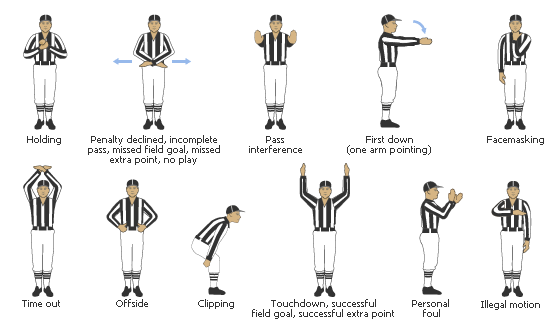
Football ref signals professional#
A referee who shows a player the red card is indicating that the player has committed a serious offense, one of the seven "deadly sins" send-off offenses, and must leave the vicinity of the field of play immediately (in professional matches, this most often means he heads to the changeroom). The cautioned player may be replaced, and/or may re-enter on the next available substitution opportunity. Under National Federation rules (US high school), a player must leave the field after receiving a yellow card (caution). A player who is issued a yellow card is noted by the referee, and if a second yellow card is issued, the player is sent off. A referee who shows a player a yellow card is indicating that the player has committed one of the seven cautionable offenses. A referee who points directly to the penalty spot, or the spot two-thirds of the way between the penalty area line and goal area line, is indicating that a player has committed a DFK offense within his own penalty area and a penalty kick has been issued. When signaling for an IFK, the referee will keep his hand up until after the ball has been kicked and touched by another player. A goal may not be scored from an IFK until it has touched another player. An IFK is awarded for any foul not falling under the category of penal foul, or a foul which is not committed against opponents.
Football ref signals free#
If after signaling for a free kick the referee keeps his hand above his head then he is signaling for an indirect free kick, or IFK. A DFK is awarded when one of the players commits one of the ten penal fouls against an opponent. To signal a direct free kick, or DFK, a referee will blow his whistle and point with a raised arm in the direction of the goal that the team who has been awarded the free kick is attacking. If the foul warranted a card, however, he will show the card at the next stoppage in play. If, at the end of the 3 seconds, an advantage was gained by the fouled team, such as possession being kept or a goal being scored, the foul will be ignored by the referee. Typically the referee will give around 3 seconds to determine who comes out on top. In advantage, the referee delays the call because he believes that the fouled team still has the advantage in the situation. A referee who, without blowing his whistle, points both arms out, has seen a foul but has decided to play advantage.

A short, quick whistle indicates a lesser foul only punished by a free kick, and longer, harder blasts indicate serious fouls punishable by cards or penalty kicks. The whistle tone will often indicate the nature of the foul. A referee who blows his whistle has seen something, most often a foul, or stoppage in play, which requires him to immediately terminate play and deal with the situation.


 0 kommentar(er)
0 kommentar(er)
